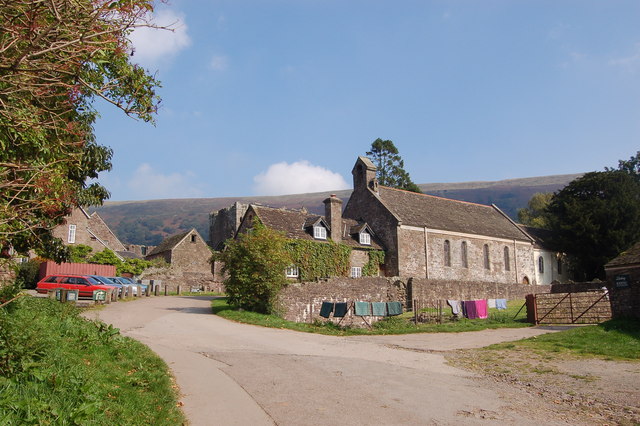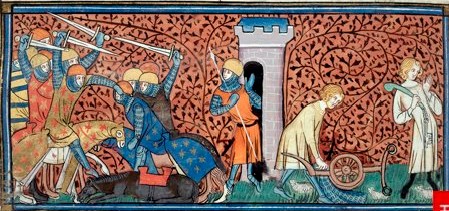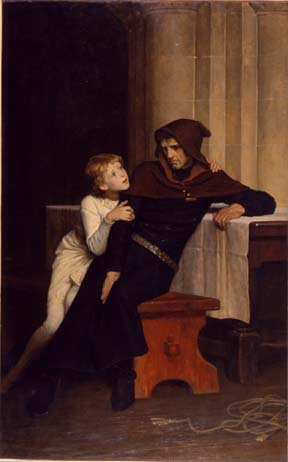|
Alix, Countess Of Eu
Alix d'Eu or Alice of Eu ( – May 1246), was ruling Countess of Eu from 1191 to 1246. She was the last ruler of the county of Eu from the House of Normandy. Biography Alix was the daughter of Henry II, Count of Eu, and Matilda, daughter of Hamelin de Warenne, Earl of Surrey, and Isabel de Warenne. Alix inherited Eu and Hastings upon her father's death in 1191 as her older brothers had both died prematurely. By 1191, Alix was married to Raoul I of Lusignan, Lord of Exoudun (died 1219), who became (through marriage with Alix: '' de jure uxoris'') Count of Eu and Lord of Hastings. Alix and Raoul had several children, including: * Raoul II de Lusignan, Count of Eu (born – died in 1250). * Matilda Lusignan ( – August 14, 1241), who married Humphrey de Bohun, 2nd Earl of Hereford, 1st Earl of Essex and Constable of England. She was buried at Llanthony, Gloucester. Her husband died in 1219, and Alix traveled to England, apparently under an arrangement with Hubert de Bu ... [...More Info...] [...Related Items...] OR: [Wikipedia] [Google] [Baidu] |
La Mothe-Saint-Héray
La Mothe-Saint-Héray () is a commune in the Deux-Sèvres department in western France. See also *Communes of the Deux-Sèvres department The following is a list of the 252 communes of the Deux-Sèvres department of France. The communes cooperate in the following intercommunalities (as of 2025):site on la mothe saint héray Communes of Deux-Sèvres {{DeuxSèvres-geo-stub ... [...More Info...] [...Related Items...] OR: [Wikipedia] [Google] [Baidu] |
Llanthony Priory
Llanthony Priory () is a partly ruined former Augustinians, Augustinian priory in the secluded Vale of Ewyas, a steep-sided once-glaciated valley within the Black Mountains, Wales, Black Mountains area of the Brecon Beacons National Park in Monmouthshire, south east Wales. It lies seven miles north of Abergavenny on an old road to Hay-on-Wye at Llanthony. The priory ruins lie to the west of the prominent Hatterrall Ridge, a limb of the Black mountains. The main ruins are under the care of Cadw and entrance is free. The priory is a Grade I listed building as of 1 September 1956. Within the precincts of the Priory are three other buildings with Grade I listed status: the Abbey Hotel, Llanthony Priory, Abbey Hotel, listed on 1 September 1956; Church of St David, Llanthony, St David's Church, listed on the same date, and Court Farm Barn, Llanthony Priory, Court Farm Barn, listed on 9 January in the same year. History Foundation The priory dates back to around the year 1100, when ... [...More Info...] [...Related Items...] OR: [Wikipedia] [Google] [Baidu] |
1180s Births , synthetic chemical element with atomic number 118
{{Numberdis ...
118 may refer to: *118 (number) *AD 118 *118 BC *118 (TV series) *118 (film) *118 (Tees) Corps Engineer Regiment *118 (Tees) Field Squadron, Royal Engineers *118 Peitho, a main-belt asteroid See also *11/8 (other) *Oganesson Oganesson is a synthetic element, synthetic chemical element; it has Chemical symbol, symbol Og and atomic number 118. It was first synthesized in 2002 at the Joint Institute for Nuclear Research (JINR) in Dubna, near Moscow, Russia, by a joint ... [...More Info...] [...Related Items...] OR: [Wikipedia] [Google] [Baidu] |
1246 Deaths
Year 1246 ( MCCXLVI) was a common year starting on Monday of the Julian calendar. Events By place Europe * February 28 – Siege of Jaén: Castilian forces, led by King Ferdinand III (the Saint), manage to take the city of Jaén from the Andalucians. In a combined assault with the knights of the Order of Santiago, the city is handed over by Sultan Muhammad I, who accepts Ferdinand's overlordship in exchange for a 20-year truce. The Emirate of Granada becomes a vassal state of the Kingdom of Castile. * May 22 – Henry Raspe is elected anti-king in Germany in opposition to Conrad IV of Germany and Conrad's father, the excommunicated emperor Frederick II. * June 15 – Battle of the Leitha River: Hungarian forces, under King Béla IV, defeat Duke Frederick II (the Quarrelsome) at the banks of the Leitha River. Frederick is killed (leaving no male heirs); the House of Babenberg is dissolved. Emperor Frederick II places the fiefs of Austria and Styria un ... [...More Info...] [...Related Items...] OR: [Wikipedia] [Google] [Baidu] |
House Of Blois
The House of Blois () was a noble family that arose in the West Francia, Kingdom of West Francia in the early 10th century, and whose prominent members were often named Theobald (''Thibaud'', ''Thibault'', ''Thibaut'' in French language, French). History This lineage came from Theobald the Elder, viscount of Tours before 908. Theobald became viscount of Blois before 922. Afterwards the House of Blois accumulated the counties of Blois, Chartres, Châteaudun and as successors of Herbertians the counties of Troyes, Reims and Meaux - core of the County of Champagne, and finally the kingdom of Navarre. The House of Blois-Champagne, which was founded by Theobold II in 1025, split into several branches. The House of Blois-Chartres, which was founded by Theobold V of Blois inherited the counties of Blois and Chartres and others in 1152. His descendants would hold the counties until the deaths of Margaret and Isabella, to which the branch became extinct in 1249. The House of Blois-Navarre ... [...More Info...] [...Related Items...] OR: [Wikipedia] [Google] [Baidu] |
13th-century Countesses Regnant
The 13th century was the century which lasted from January 1, 1201 (represented by the Roman numerals MCCI) through December 31, 1300 (MCCC) in accordance with the Julian calendar. The Mongol Empire was founded by Genghis Khan, which stretched from Eastern Asia to Eastern Europe. The conquests of Hulagu Khan and other Mongol invasions changed the course of the Muslim world, most notably the Siege of Baghdad (1258) and the destruction of the House of Wisdom. Other Muslim powers such as the Mali Empire and Delhi Sultanate conquered large parts of West Africa and the Indian subcontinent, while Buddhism witnessed a decline through the conquest led by Bakhtiyar Khilji. The earliest Islamic states in Southeast Asia formed during this century, most notably Samudera Pasai. The Kingdoms of Sukhothai and Hanthawaddy would emerge and go on to dominate their surrounding territories. Europe entered the apex of the High Middle Ages, characterized by rapid legal, cultural, and religious evol ... [...More Info...] [...Related Items...] OR: [Wikipedia] [Google] [Baidu] |
12th-century Countesses Regnant
1 (one, unit, unity) is a number, numeral, and glyph. It is the first and smallest positive integer of the infinite sequence of natural numbers. This fundamental property has led to its unique uses in other fields, ranging from science to sports, where it commonly denotes the first, leading, or top thing in a group. 1 is the unit of counting or measurement, a determiner for singular nouns, and a gender-neutral pronoun. Historically, the representation of 1 evolved from ancient Sumerian and Babylonian symbols to the modern Arabic numeral. In mathematics, 1 is the multiplicative identity, meaning that any number multiplied by 1 equals the same number. 1 is by convention not considered a prime number. In digital technology, 1 represents the "on" state in binary code, the foundation of computing. Philosophically, 1 symbolizes the ultimate reality or source of existence in various traditions. In mathematics The number 1 is the first natural number after 0. Each natural number, ... [...More Info...] [...Related Items...] OR: [Wikipedia] [Google] [Baidu] |
House Of Lusignan
The House of Lusignan ( ; ) was a royal house of France, French origin, which at various times ruled several principalities in Europe and the Levant, including the kingdoms of Kingdom of Jerusalem, Jerusalem, Kingdom of Cyprus, Cyprus, and Kingdom of Cilicia, Armenia, from the 12th through the 15th centuries during the Middle Ages. It also had great influence in Kingdom of England, England and Kingdom of France, France. The family originated in Lusignan (Vienne), Lusignan, in Poitou, western France, in the early 10th century. By the end of the 11th century, the family had risen to become the most prominent petty lords in the region from their Château de Lusignan, castle at Lusignan. In the late 12th century, through marriages and inheritance, a cadet branch of the family came to control the Kingdom of Jerusalem, kingdoms of Jerusalem and Kingdom of Cyprus, Cyprus. In the early 13th century, the main branch succeeded to the County of La Marche, Counties of La Marche and County of ... [...More Info...] [...Related Items...] OR: [Wikipedia] [Google] [Baidu] |
Louis IX, King Of France
Louis may refer to: People * Louis (given name), origin and several individuals with this name * Louis (surname) * Louis (singer), Serbian singer Other uses * Louis (coin), a French coin * HMS ''Louis'', two ships of the Royal Navy See also * Derived terms * King Louis (other) * Saint Louis (other) * Louis Cruise Lines * Louis dressing, for salad * Louis Quinze, design style Associated terms * Lewis (other) * Louie (other) * Luis (other) * Louise (other) * Louisville (other) Associated names * * Chlodwig, the origin of the name Ludwig, which is translated to English as "Louis" * Ladislav and László - names sometimes erroneously associated with "Louis" * Ludovic, Ludwig, Ludwick, Ludwik Ludwik () is a Polish given name. Notable people with the name include: * Ludwik Czyżewski, Polish WWII general * Ludwik Fleck (1896–1961), Polish medical doctor and biologist * Ludwik Gintel (1899–1973), Polish-Israeli ... [...More Info...] [...Related Items...] OR: [Wikipedia] [Google] [Baidu] |
Justiciar
Justiciar is the English form of the medieval Latin term or (meaning "judge" or "justice"). The Chief Justiciar was the king's chief minister, roughly equivalent to a modern Prime Minister of the United Kingdom. The Justiciar of Ireland was an office established during the Anglo-Norman invasion of Ireland and was a key tool in its colonisation. Following the conquest of the Principality of Wales in the 13th century, the areas that became personal fiefs of the English monarchs were placed under the control of the Justiciar of North Wales and the Justiciar of South Wales. A similar office was formed in Scotland, although there were usually two or three – the Justiciar of Scotia, the Justiciar of Lothian and, in the 13th century, the Justiciar of Galloway. These offices later evolved into a national one called Lord Justice-General. The modern title is Lord President of the Court of Session. Similar positions existed in continental Europe, particularly in Norman Italy ... [...More Info...] [...Related Items...] OR: [Wikipedia] [Google] [Baidu] |
Hubert De Burgh, 1st Earl Of Kent
Hubert de Burgh, Earl of Kent ( , ; – before 5 May 1243) was an English nobleman who served as Justiciar, Chief Justiciar of England (1215–1232) and Chief governor of Ireland, Justiciar of Ireland (1232) during the reigns of King John, King of England, John and his son and successor King Henry III of England, Henry III and, as Regent, Regent of England (1219–1227) during Henry's minority, was one of the most influential and powerful men in English politics in the thirteenth century. Origins Hubert de Burgh was born of unknown parents of Burgh-next-Aylsham, Norfolk. A case has been made for Hubert's father being Walter de Burgh, and his mother was named Alice. The family were minor landholders in Norfolk and Suffolk, from whom Hubert inherited at least four manors. His elder brother was William de Burgh (d. 1206), founder of the House of Burgh, de Burgh/Burke/Bourke (surname), Bourke dynasty in Ireland, and his younger brothers were Geoffrey de Burgh, Geoffrey (Archdeaco ... [...More Info...] [...Related Items...] OR: [Wikipedia] [Google] [Baidu] |
Constable Of England
The Lord High Constable of England is the seventh of the Great Officers of State, ranking beneath the Lord Great Chamberlain and above the Earl Marshal. This office is now called out of abeyance only for coronations. The Lord High Constable was originally the commander of the royal armies and the Master of the Horse. He was also, in conjunction with the Earl Marshal, president of the court of chivalry or court of honour. In feudal times, martial law was administered in the court of the Lord High Constable. The constableship was granted as a grand serjeanty with the Earldom of Hereford by the Empress Matilda to Miles of Gloucester, and was carried by his heiress to the Bohuns, earls of Hereford and Essex. They had a surviving male heir, and still have heirs male, but due to the power of the monarchy the constableship was irregularly given to the Staffords, Dukes of Buckingham; and on the attainder of Edward Stafford, 3rd Duke of Buckingham, in the reign of Henry VIII, it bec ... [...More Info...] [...Related Items...] OR: [Wikipedia] [Google] [Baidu] |



